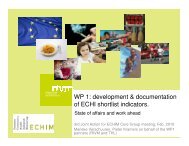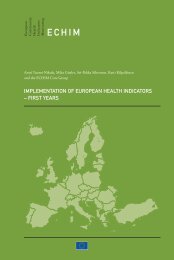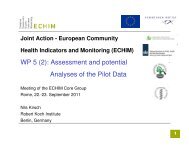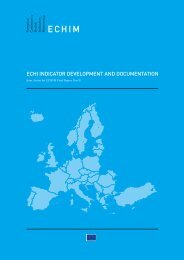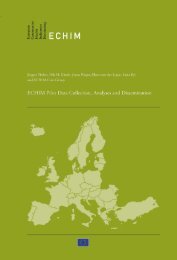INDICATORS
ECHIM Final Report
ECHIM Final Report
You also want an ePaper? Increase the reach of your titles
YUMPU automatically turns print PDFs into web optimized ePapers that Google loves.
Notes: Total alcohol consumption can be calculated also per whole population. The use<br />
of this indicator is mainly related with the existing correlation between the level of the per<br />
capita alcohol consumption and the level of the alcohol related problems and diseases in<br />
the population. The limit of this indicator is that does not allow to evaluate adequately the<br />
at risk population according to sex and age as the definition and calculation refers to all the<br />
individuals (usually aged 15+) disregarding the status of drinkers or teetotaller.<br />
47. HAZARDOUS ALCOHOL CONSUMPTION<br />
Definition: Hazardous alcohol consumption is as an average rate of consumption of more<br />
than 20g pure alcohol daily for women and more than 40g daily for men. Hazardous alcohol<br />
consumption is a level of consumption or pattern of drinking that is likely to result in harm<br />
should present drinking habits persist. For the individual drinker, the higher the alcohol<br />
consumption, the greater the risk.<br />
Calculation:<br />
1) Percentage of men/women having at least X times 6 or more drinks on one occasion<br />
during the past 12 months, derived from EHIS questions AL.1 and AL.3. AL.1: During the<br />
past 12 months, how often have you had an alcoholic drink of any kind (that is beer, wine,<br />
spirits, liqueurs or other alcoholic beverages)? 1. Never / 2. Monthly or less / 3. 2 to 4 times<br />
a month / 4. 2 to 3 times a week / 5. 4 to 6 times a week / 6. Every day. If 2 to 3 times a<br />
month or more often, then AL.3: During the past 12 months, how often did you have 6 or<br />
more drinks on one occasion? 1. Never / 2. Less than monthly / 3. Monthly / 4. Weekly / 5.<br />
Daily or almost daily. Precise operationalisation to be formulated.<br />
2) Percentage of men/women having over the week on average ≥2 drinks/day (women) or ≥3<br />
drinks/day (men), derived from EHIS question AL.2: How many drinks containing alcohol<br />
do you have each day in a typical week when you are drinking? Start with Monday and take<br />
one day at a time. Number of drinks of: Beer, Wine, Liqueur, Spirits, Other local alcoholic<br />
beverage. Precise operationalisation to be formulated.<br />
3) Percent of adolescents, adults consuming > 20 g (women), or > 40 g ethanol/day (men).<br />
It is calculated from total alcohol consumption data combined with data on abstinence, sex<br />
and age groups and information on drinking patterns (WHO-CHOICE project; Rehm et<br />
al., 2004).<br />
4a) Recommendation by Working Party Mental Health: AUDIT-5 score of ≥5 for questions<br />
1, 2, 4, 5 and 10 of the original Alcohol Use Disorders Identification Test (AUDIT-10)<br />
indicates hazardous alcohol consumption.<br />
4b) AUDIT-C score >5 for man and >4 for women for questions 1–3 of the Alcohol Use<br />
Disorders Identification Test (AUDIT-10) indicates hazardous alcohol consumption (to be<br />
confirmed by mean of the full AUDIT).<br />
Notes: Threshold for “hazardous” alcohol consumption is usually considered higher for<br />
men than for women. According to the WHO, morbidity and mortality due to alcohol<br />
consumption rises when the limits of 21 drinks/week (3 glasses/day) for men and 14 drinks/<br />
week (2 glasses/day) for women are exceeded.<br />
48. USE OF ILLICIT DRUGS<br />
Definition: Prevalence for illicit use of specific psychoactive drugs (cannabis, cocaine,<br />
amphetamine, ecstasy, LSD) among adults and school students, a) Lifetime prevalence and<br />
b) last year prevalence.<br />
111





